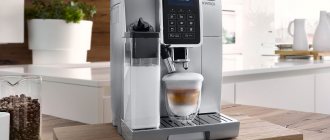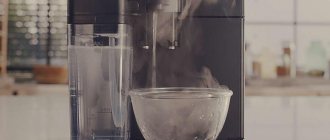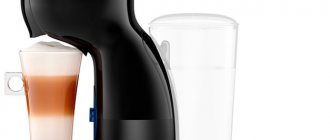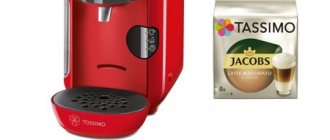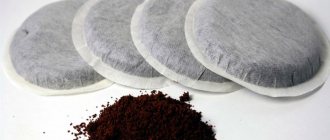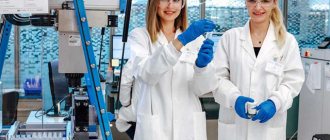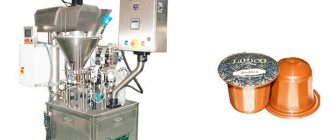Common to all coffee machines: There is nothing complicated in cleaning coffee fats and decalcifying; they are designed for self-service by the user of the coffee machine. Decalcification and cleaning from coffee fats should be carried out when a signal appears. If the model of coffee machine you are using does not have an automatic cleaning function, this does not mean that it does not need to be cleaned. The condition of the coffee machine and cleaning time must be determined independently based on the amount of coffee prepared. It is advisable to clean at least once a month.
These procedures are described in detail in the operating instructions that come with the coffee machine. The procedure differs in different models, so it’s better to find the instructions and look through them.
How and from what does scale form?
We do not use sterile water for preparing food and drinks. Even filtered or bottled water contains a certain set of minerals. These include calcium, magnesium, iron. When water is heated, some of these minerals form an insoluble precipitate that remains at the points of contact between the heating elements and the water. Over time, sediment accumulates, the layers harden and form a crust. It's called scale. The more impurities in the water, the faster scale forms.
Scale can form in a coffee machine even from filtered or bottled water. The harder the water, the faster scale forms.
Causes of scale
The first thing you need to know is that cleaning scale not only affects the appearance of the device, but also extends its service life. The heating process is faster, and the risks of breakdowns are minimized.
Scale forms over time on any device where water is heated - an inevitable process. Water, no matter how purified it is, contains salts and various mineral compounds. Basically, during heating, some substances are transformed into others, more complex ones - they are calcium and magnesium salts. The main condition for the formation of new compounds is heating the liquid to a temperature of at least 40 °C.
When heated, 2 complex reactions occur simultaneously. Water quality only partially affects the amount of mineral compounds obtained. No matter how hard a person tries, it is impossible to avoid a chemical reaction when heating liquid in a coffee maker or coffee machine.
The only way to minimize the amount of plaque is not to completely remove it, but only partially reduce it, and put filters on the taps where water for cooking comes from.
Filters must be ion exchange, new generation. They magnetize water, so it is less hard and not so harmful to pipes, faucets and various equipment. The process of scale formation is the same for both a coffee machine and a coffee maker: the liquid heats up, salts are released, and they settle on individual parts of the device.
What is decalcification of a coffee machine?
The basic element of scale is calcium salts. They have a loose, porous structure and easily add other elements from the water: iron, magnesium, potassium, fluorine. Decalcification is the removal of mineral plaque by softening the calcium crust. It is impossible to scrape off plaque by mechanical means. Rough intervention is dangerous as it can damage the heating elements of the coffee machine.
Therefore, decalcification is carried out using special means that react chemically with calcium salts. As a result, the crust softens, crumbles and is easily removed with water. Modern industry produces ready-made products to combat plaque. Some coffee machine owners prefer traditional, low-cost life hacks that help deal with this problem.
How not to clean a coffee maker
When cleaning, it is important not to damage the device with incorrectly selected cleaning agents.
The following recommendations will help you avoid problems:
- Do not add other substances to ready-made chemical descaling solutions to avoid rendering the cleaning ineffective.
- Do not use abrasives containing chlorine or soda to avoid damaging the device.
- Do not use tap water for cleaning, as it often contains high salt concentrations. Use purified water.
Why is decalcification necessary or why is scale dangerous?
Limescale in a coffee machine is dangerous both for equipment and for humans. Deposits cause problems with the heating element. In a coffee machine it is very small, so even minor interference will interfere with its effectiveness. The scale forms a kind of coupling around the heating element, interfering with heat transfer. The result is a double negative effect.
- The heating element overheats and can burn out from excess heat
- The coffee water is not hot enough.
Insufficiently heated water does not do a good job of brewing coffee; the drink turns out sour, weak and cloudy due to underextraction.
Repair shops will tell you cases where not only heating elements, but also the entire body of the coffee machine suffered due to limescale deposits. Over time, lime corrodes fastening and connecting elements.
How else is scale dangerous?
- Blockage of the water passage in the system.
- Blocking the tap through which coffee flows into the cup.
- Getting into a cup of coffee.
- The proliferation of bacteria that thrive in the loose structure of limescale.
Decalcification extends the life of the coffee machine and allows you to prepare tasty and safe coffee.
Signs of a dirty coffee maker
If water with salts is used, scale will inevitably form. It appears on simple drip devices, and on capsule or even horn devices. What influences the formation of a large amount of scale: the shape of the internal parts of the device. Salt particles clog parts as water passes through.
Simple devices are not equipped with special indicators that allow you to recognize a problem, so you will have to focus on certain symptoms of a future problem:
- The boiling time for water has increased - preparing a drink takes many times longer than before.
- If the main tube is clogged, the stream of coffee decreases, so it takes longer to fill the cup.
- Along with the deterioration of the device’s performance, the taste of the finished coffee also deteriorates.
- The coffee maker makes new and uncharacteristic sounds - it hums loudly.
- Another important sign is that there is sediment left at the bottom of the cup: not coffee, but sediment that tastes unpleasant.
For you:
How to choose a coffee machine for a small, mobile or traditional coffee shop
A faulty device consumes more electricity, so a high light bill can also reveal hidden problems with the device. Heating elements are most susceptible to plaque formation - in capsule, carob and boiler devices. If the device has a thermoblock, water does not stagnate in it - it breaks less often.
If the causes of the problems are identified, special cleaning is carried out to remove scale. The sediment itself will not disappear, but the operation of the coffee maker will only worsen. There are 2 options available to correct the problem - self-cleaning or work carried out by a repairman.
When should decalcification be carried out?
The timing of the decalcification procedure is indicated in the instructions for the coffee machine. Automatic coffee makers can themselves report the need for a procedure. You should not think that the machine evaluates the state of the water and its elements. It is programmed to decalcify after a certain number of cups of coffee are prepared. All machines are designed for use with hard water.
If your machine is not equipped with reminder functions, and the instructions do not contain anything about decalcification periods, then rely on the following recommendations from service specialists.
- If you only use bottled water, you can decalcify once every 10-12 months.
- If you use filtered water, then decalcification should be done every 6-8 months.
- If your area has hard water and you use a filter, then decalcification should be done after 4-6 months.
- If your area has hard water and you do not use a filter, then decalcification should be carried out every 3-4 months.
Indirect signs of the need for decalcification may include:
- musty smell of coffee;
- increased machine noise;
- foreign impurities in coffee.
How often should you clean your coffee machine?
In principle, the frequency of cleaning this device mainly depends on the quality of the water. If hard water is used, it is recommended to clean it at least every month and a half. For soft water, this period increases to six months. You can wash the machine, focusing on external signs - an indication of the device itself or a change in the nature of its operation. This will be discussed in more detail below.
In addition to decalcification, you need to regularly clean the cappuccino machine - a device for frothing milk. It is recommended to rinse this unit with bottled water after each use, as... milk residues are a favorable environment for the proliferation of microorganisms, including pathogens. In addition, without rinsing, sediment accumulates in the cappuccino maker over time, and this unit stops frothing milk. In this case, it will have to be washed with a special washing liquid.
Coffee machine decalcifiers
There are many means for decalcifying a coffee machine, which can be divided into specialized and popular ones.
Specialized decalcification products
Specialized preparations for decalcification are produced in the form of liquid and tablets.
Liquids are sold in bottles for 1-2 uses. Many manufacturers of coffee equipment prescribe in their instructions the use of only branded products of the corresponding brand: Bosch or Saeco.
There are multi-brand liquids for universal use, for example, Top House or Filtero.
The compositions of all products use the same active substances, so it is quite possible to use any universal product for decalcification.
Tablet preparations differ in the form of release and the concentration of active substances. One or two tablets are usually enough to clean the coffee machine. Tablet products are cheaper than liquid ones.
Folk remedies for cleaning coffee machines
These include citric acid. An acidic environment softens calcium deposits well. The acid is diluted at the rate of 10 g per 1 liter of water and the resulting solution is used.
Citric acid is inferior in effectiveness to specialized products. Some experts consider it too aggressive for the heating element and the body of the coffee machine. The use of citric acid can damage the protective coating of heating elements and they will begin to rust.
No other types of acids can be used for decalcification, not even the popular acetic or oxalic acids. They are too aggressive for the internal structure of the coffee machine.
Professional and folk remedies for cleaning devices
Specialized stores have descaling products - a good, but expensive option. New models also have the ability to automatically clean: such devices are expensive, but they do not require frequent preventive measures - after the hundredth or two hundredth cup, the parts are automatically cleaned.
Professional products are presented in the form of powders or some tablets. They are easy to use and also easy to store at home until the next time you use the coffee maker. The manufacturer of any device insists that only professional products must be used so as not to harm the parts.
If you look at the composition of specialized products, they mainly contain citric acid and several additional substances in small proportions. Due to the simplicity of the composition, a similar product can be prepared with your own hands - it will cost less. Citric acid is also used as a basis.
Why citric acid is a universal remedy: the component is safe for the environment and does not harm humans in any way; with its help, delicate and very gentle cleaning is carried out - individual parts are not damaged. Citric acid is also suitable for removing varying degrees of contamination, even very old scale - the product is used in the form of a crystalline substance.
How to descale a coffee machine?
Automatic coffee machines in the high price segment have special cleaning programs. You need to pour liquid descaling agent into the machine and run it in the desired program. If you are using tablets, the drug must be diluted in water according to the instructions and, after complete dissolution, the tablets must be used in the same way as a liquid product.
In some models, a special program is not provided and cleaning is performed in a sequence of actions. The entire procedure is described in the instructions for the coffee machine.
Semi-automatic and many automatic coffee makers are cleaned by simply running the coffee program. Do not add grains; instead of water, add cleaning liquid or a tablet diluted in water. The resulting “drink” is immediately poured out and the procedure is repeated with plain clean water, without any means.
The decalcification procedure is always described in the instructions for the coffee machine. Therefore, strictly adhere to the sequence of actions. The only place where deviation is appropriate is the choice of means. You can take a generic one rather than a branded one, or replace the liquid with tablets.
Methods for decalcifying a heating element
If you read the article before all these problems arise, they can be prevented. Just take the instructions for your device. It describes in detail all points of the process. The simpler the coffee machine, the more sequences, the more complex the technique, the shorter the process becomes. Instructions for decalcifying a coffee machine are your lifesaver. It would be unnecessary to describe the entire sequence here, since each device has its own. If the instructions are lost or you are tasked with cleaning office equipment, you have several options:
- Find a manual online. To do this, you need to enter the full name of the coffee machine, get the manual, find in it the item “Methods of care and cleaning” or something similar. Large manufacturers such as Delonghi or Jura can print everything you need on their websites.
- Invite your device into your home or send it to a service center, where experienced technicians will clean it for you. In this case, you need to remember - you will pay not only for the liquid or cleaning tablets, but for the work.
Manual cleaning
The third point is to try to perform standard manipulations with the coffee maker. You might be lucky - it won't get worse, it might just not work.
- Fill the reservoir with water, add the product to the liquid in a certain proportion, which is indicated on the bottle.
- Turn on the machine, make coffee without coffee.
- Wash the tank, fill it with clean water, repeat the process several times in the absence of coffee.
- Dry the coffee machine.
Real coffee
It’s easy to check how clean your coffee maker is - try making one of your favorite drinks. If everything is in order, you win.
There are tablets for decalcifying coffee machines. In most coffee makers the process goes like this.
- The tablet is placed in the bean receiver.
- Water is poured into the reservoir.
- The “ground coffee” process starts.
- Coffee preparation begins without the presence of beans.
- After the process is completed, it is necessary to clean the cake compartment from tablet remnants.
- Fill the reservoir with water and repeat without coffee to rinse the machine.
If your technique refuses to “cook” the tablet, you will have to trick the machine. This can be done by dissolving the product in water and loading the grains. This “coffee” will have to be thrown away.
Squesito capsule coffee machine
How much does decalcification and refusal cost?
The most painful issue is financial. Many people think that decalcification is too expensive. Let's do the math.
- 800-1200 rubles for a bottle of branded cleaning liquid. It is enough for 1-2 uses.
- 150 to 500 rubles per bottle of a universal product.
- 200-450 rubles per pack of tablets, one tablet – one cleaning cycle.
We find that the cost of a cleaning “session” ranges from 50 to 600 rubles.
How much does it cost to not descale your coffee machine?
A burnt heating element will lead to replacement of the boiler, and this costs from 8-10 thousand without transportation costs.
Cleaning Recommendations
A few tips will help you avoid damage to your coffee system and descale it more effectively:
- completely dissolve powders and tablets in water before use, mix liquids with water;
- remove the filter from the tank to avoid damaging it with cleaning agents;
- Completely clean the machine by removing all parts every 300-400 cups of coffee.
Limescale is the main enemy of all coffee machines. The quality of the water used to make coffee will determine how often you clean the machine and its lifespan. To determine hardness, it is recommended to use special test strips.
Hard tap water is not suitable for drinking; it must be filtered or already purified water used. If the filter is built-in, it must be changed at least once every 3 months.
Decalcification of coffee makers without auto-cleaning function
Inexpensive models of coffee makers often do not have an automatic decalcification function.
A general algorithm has been developed for such models:
- Clean trays and filters by hand.
- Pour the descaling agent into a container of water.
- Place a container for drainage under the built-in cappuccino maker.
- Start cleaning, letting in the cleaning agent gradually.
- Rinse all removable parts under running water.
- Brew a couple of servings of coffee and be sure to pour them out.
Descaling coffee maker with automatic cleaning function
The presence of an automatic descaling function in the coffee machine greatly simplifies the maintenance of the device. After the indicator turns on, signaling the need for cleaning, all that remains is to pour water into the container, add a cleaning agent and start the process. Then periodically follow the instructions that appear on the display. This is usually a request to add water or restart cleaning one of the blocks.
Cleaning your drip coffee maker
Popular and inexpensive drip coffee makers are recommended to be descaled once a month. You can clean such a coffee maker from limescale deposits, like any other, using the general algorithm for machines with a self-cleaning function, if any, or according to the rules for cleaning a machine without a self-cleaning function. Both home and professional remedies are suitable for decalcification.
Cleaning the carob coffee maker
When deciding how to clean a carob coffee maker from limescale, pay special attention to the horn (holder) and tube. After passing the cleaning solution through the device, you need to unscrew the horn, disassemble it and thoroughly rinse all parts in running water with a sponge. General decalcification guidelines will also apply.
Useful tips and tricks
Following simple rules will not only extend the life of the equipment, but will save you from many problems. What can be highlighted:
- You need to use high quality water. You shouldn’t brew drinks from a regular instant pot, as neither the clients nor the equipment itself will say “thank you.”
- Remove milk deposits in a timely manner.
- Inspect and clean the machine regularly.
All brands and models are susceptible to limescale. Therefore, decalcification should not be neglected.
Cleaning technology using citric acid
Most equipment repair specialists find this method more acceptable and safer. To make a cleaning product, you need to dilute 30 g of acid per 1 liter of water. After this, it is recommended to use the same algorithm of actions as described above - the principle of operation is the same as that of specialized cleaning products. Experts in this field say that citric acid will indeed effectively remove accumulated scale, but if you overdo it, the solution can negatively affect the operation of the parts of the entire coffee machine. It is better to use such a product rarely, so as not to damage the device ahead of time.
How often to do a decalcification program
It’s worth considering whether everything is okay with your device as soon as you notice that:
- the flow of the finished drink fades away;
- the foam ceases to be fluffy and thick;
- The resulting coffee turns out barely warm, and its delicate and pleasant taste deteriorates.
It might not hurt to clean the machine of oily coffee deposits and scale. After all, these factors negatively affect the heating and supply of the drink and even block the internal parts of the device.
So, in order to prevent this, we recommend removing formations at regular intervals, the frequency of which depends on the degree of hardness of the water consumed.
Reference. To find out what level of water hardness you have, do a test. Take a special test strip and dip it in the liquid. The degree of color will indicate the concentration of calcium in the water.
There are options for coffee machines with automatic detection of water hardness level. For them, it is enough to specify the parameter once in the coffee machine menu, and the program will remember it. However, in the absence of instructions, the machine will operate at the factory setting. That is, you will have to clean the device after each boiler containing 30 liters of water is poured.
When the water hardness level is within normal limits, the coffee device will require cleaning only after using 120-240 liters of water.
The conclusion follows from this: so that the coffee machine does not require descaling ahead of time, it must be adjusted in accordance with the actual degree of water hardness. The harder the water used to prepare the drink, the more often the device should signal the advisability of descaling.
It is important for coffee machine users to monitor the quality of the prepared drinks and even wash them ahead of time if necessary. A simple way to recognize when cleaning is due is the presence of white sediment in the mug.
Types of specialized tools
There are two types of special anti-scale and lime scale agents for coffee machines:
- Pills. Produced in the form of briquettes, convenient for dosing and use.
- Liquids. Such solutions are more suitable for cases where limescale deposits are insignificant.
Branded universal products suitable for each category of coffee machines are popular. Among them, Melitta liquid cleaner is distinguished, which has an unlimited service life and a safe composition. The product is designed to remove residues of dairy products.
Cleaners from Saeco and DeLonghi are in demand, as are their coffee machines. Since the price of the products is higher than average, it is more profitable to purchase them in sets. One half-liter jar is enough for five cleanings.
In addition to cleaning functions, DeLonghi liquids have antibacterial and disinfectant properties. With their help it is easy to remove dirt and unpleasant odors.
Bosch produces its own line of cleaners in the form of tablets and liquid formulations. Both options remove scale without leaving a trace, but the tablets are more expensive. After using these products, rinse the coffee machine thoroughly and pass water through the coffee maker several times without preparing a drink.
Important! It is preferable to clean expensive software coffee machines with branded products, since a low-quality product can affect the operation of the equipment. In addition, decalcification of such expensive complex machines is carried out strictly according to the instructions.
What not to do
There are only a few basic rules that will extend the life of your coffee machine:
- You should not remove the heating element yourself.
- Do not remove scale with sharp objects.
Acids cannot be used for decalcification, even the popular acetic or oxalic acids. They are too aggressive for the internal structure of the coffee machine.
Many manufacturers write about restrictions in the manual for using the device. It is advisable to study it before starting cleaning.
